|
Overview The Tule Pond System is a storm water demonstration project in Fremont. Storm water enters the system through Pond A, where heavy metals from storm water will settle out. Pond B and C further clean the water which then flows into the existing Tyson Lagoon before it flows through flood control drainage to Mowry Slough and finally out to the San Francisco Bay. Math/Science Nucleus coordinates several educational programs for schools K-12 and research projects for high school students. The facility is owned by Alameda County Flood Control and Conservation District. Consult "Background Information" to learn more about the history of this unique area. Geologic information is also included in this section.
Vegetation Several species of willows (Salix spp.) grow along the berm to the northeast and southwest corner of the pond. The blue elderberry (Sambucus mexicana) grow near the southwestern corner of the pond near Walnut Way. Hydrophytic herbaceous plants, are found in seasonal wetlands, as well
as plants that are normally rooted under water but extend above the water
surface (emergent plants). The northwestern corner is shallow and dries up toward summer. Low-growing wetland vegetation is present, consisting mainly of Italian wild rye, umbrella sedge (Cyperus eragrostis), rabbit's foot grass (Polypogon monspeliensis), sweet clover (Melilotus indica), and hyssop loosestrifte (Lythrum byssopifolium). The water smartweed (Polygonum amphibium) occurs along the edge of the pond, except in stands of great bulrush (Scirpus acutus var. occidentalis) and cattails (Typha sp.).
Non-native grasses, such as wild oats (Avena spp.), Ripgut brome (Bromus diandrus), and foxtail barley (Hordeum murinum ssp. leporinum), dominate the vegetation on the berm, the banks around the northern end of the pond. Wildlife
Birds using the pond to forage for prey include great blue heron, great egret, snowy egret, green heron, ring billed gull, Caspian tern, and Forster's tern. The open water provides resting habitat for ducks and geese. |

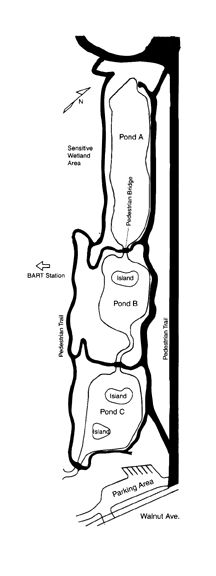 SCIENTIFIC INFORMATION
SCIENTIFIC INFORMATION
 If
you would like to learn more about the different species (native and
non-native) that you can view at Tule Ponds and Tyson Lagoon look at the
various sections including Vertebrates, Plants, Invertebrates, and
Microorganisms.
If
you would like to learn more about the different species (native and
non-native) that you can view at Tule Ponds and Tyson Lagoon look at the
various sections including Vertebrates, Plants, Invertebrates, and
Microorganisms.
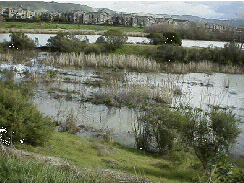 At Tyson Lagoon, Italian wild rye (Lolium
multiflorum), bird's foot trefoil (Lotus corniculatus), broad
leaved peppergrass (Lepidium latifolium), and Mediterranean barley
(Hordeium marinum ssp. gassoneanum), dominate the northeast berm.
At Tyson Lagoon, Italian wild rye (Lolium
multiflorum), bird's foot trefoil (Lotus corniculatus), broad
leaved peppergrass (Lepidium latifolium), and Mediterranean barley
(Hordeium marinum ssp. gassoneanum), dominate the northeast berm.
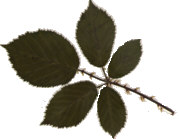 The
non native himalayan blackberry (Rubus discolor), grows along the
bands at the northern tip of the pond.
The
non native himalayan blackberry (Rubus discolor), grows along the
bands at the northern tip of the pond.
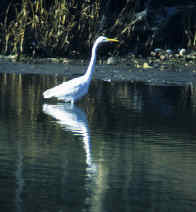
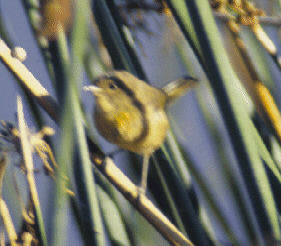 Vegetation
surrounding the lagoon provides a nesting and foraging habitat for numerous
wildlife species. The following birds may use the site as a nesting ground,
including mourning dove, Anna's hummingbird, black phoebe, scrub jay, bushtit,
northern mockingbird, yellow warbler, black-headed grosbeak, California
towhee, song sparrow, northern oriole, house finch, and lesser goldfinch.
Other birds observed breeding in the area include pied billed grebe, mallard,
American coot, red tailed hawk and red-winged blackbird.
Vegetation
surrounding the lagoon provides a nesting and foraging habitat for numerous
wildlife species. The following birds may use the site as a nesting ground,
including mourning dove, Anna's hummingbird, black phoebe, scrub jay, bushtit,
northern mockingbird, yellow warbler, black-headed grosbeak, California
towhee, song sparrow, northern oriole, house finch, and lesser goldfinch.
Other birds observed breeding in the area include pied billed grebe, mallard,
American coot, red tailed hawk and red-winged blackbird.